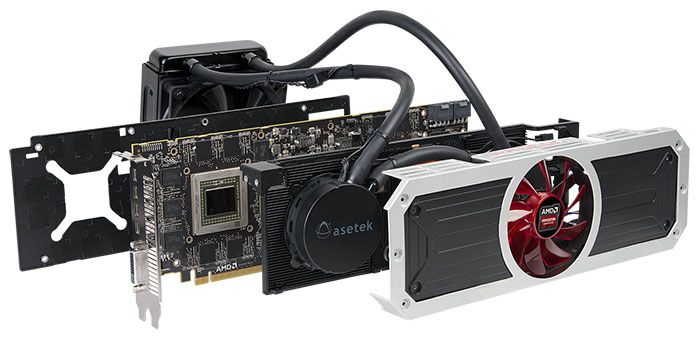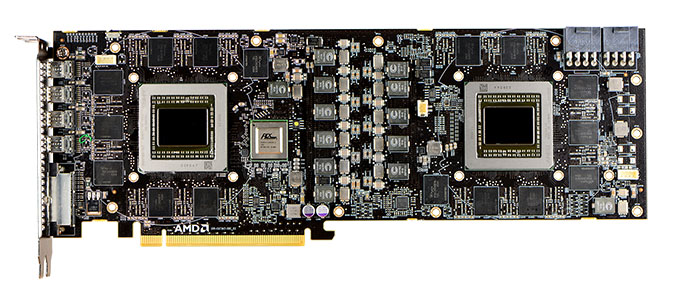Construction
And thar she blows! The Radeon R9 295X2 uses a closed-loop system that requires no assembly from the user's point of view. The main card is presented in a dual-slot form factor that's only made possible by having external cooling. Build quality is very good; the X2 feels like a premium offering.
Past experiences have shown that AMD needs a wide PCB in order to accommodate two side-by-side GPUs, bridging chip and ancillary components. X2 has the same dimensions as the HD 7990, that is, a 12in-long PCB. So why a fan on a liquid-cooled card? Though looking a little like the Asus ROG Poseidon from an initial inspection, the single fan is solely purposed with cooling the VRMs, RAM chips and regulators.
The fan switches off when, over time, the card enters ZeroCore Power mode, usually when the GPUs are running in a long-idle state characterised by a static screen. Adding a little glitz, the Radeon logo is lit when the card is in operation.
This exploded view provides a better glimpse into what's going on. The anodised aluminium shroud is merely a cover for the card. Underneath, Asetek is the go-to choice for cooling each GPU. Two integrated pumps and cold-plates, custom-designed for this model, are situated on a metal platform that directly fits over the PCB. A small central heatsink cools the aforementioned VRMs, which is in turn cooled by the fan.
The cooling actually has much in common with the Asus Ares II, which we presume AMD used as a blueprint when designing its own dual-GPU model.
Similarities with the Asus card run deeper than just the cooling, however, as AMD also uses the same four-piece ensemble - shroud, cooling, PCB, and rear metal brace - that fit together nicely. Heck, it's even packaged in the same metal briefcase.
AMD's finally learned a thing or two about industrial design. Snaking away from the card are two 380mm tubes that connect to a radiator-and-fan assembly. This is a standard 120mm radiator that's 38mm in depth. The pre-installed 120mm fan increases the bulk to 64mm.
Total installation takes less than five minutes. Simply install the Radeon R9 295X2 into the primary PCIe x16 slot, remove the rear exhaust fan from your chassis, assuming it has one, screw in the radiator from the back, and you are good to go. The radiator's fan is cabled up to the card, meaning that no additional fan-headers need to be used. The speed of this fan is regulated by the temperature of the card, though, unlike the shroud's, it never switches off.
PCB design isn't that far removed from the HD 7990's. PLX provides the bridging chip, each GPU has access to its own, non-shared 4GB of GDDR5 memory, while two full-fat Hawaii chips bestride the card. The key difference, this time around, is that significantly more power and heat is generated by the duo.
Four mini-DisplayPort (mDP) and a dual-link DVI are favoured outputs. A single mDP can drive a 4K panel at up to 60Hz, mind, so there will be no problem in powering esoteric display configurations through Eyefinity.
Understanding the complexity of the design and need for liquid cooling it is very unlikely that AMD's partners will bring custom-designed R9 295X2 cards to the market; the sheer engineering expense is likely to wipe out any potential profits.
We've yet to touch on the price, which at $1,499 is well over twice the cost of two R9 290X cards in tandem. Did we expect any different, especially considering this card is likely to have no performance peer until Titan Z is in the wild? The answer is no: you're playing for exclusivity and class-leading numbers. What's more, understanding this is likely to be a limited-edition run, the ultra-enthusiast gamer is competing against the bit-coin miners for this card.













